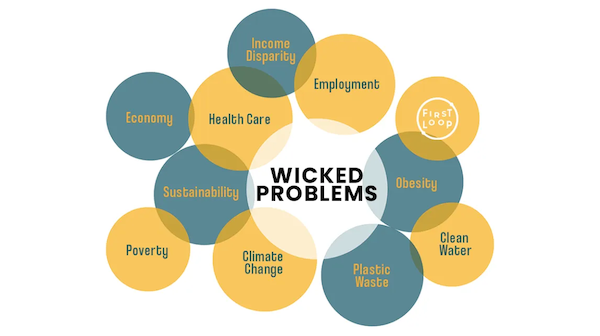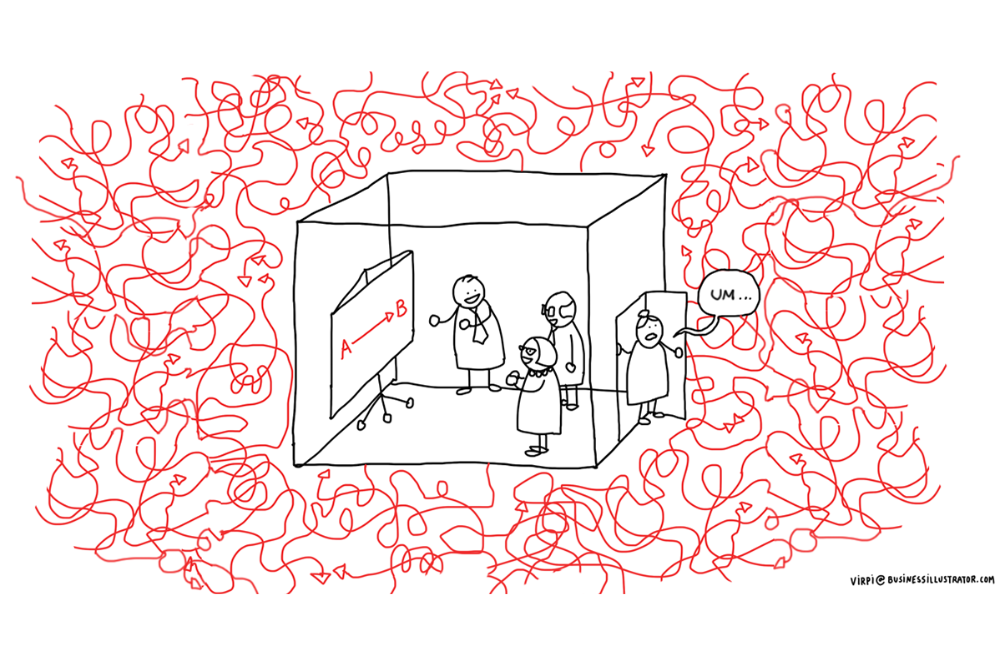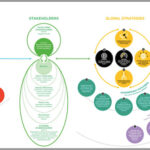Development practitioners don’t have it easy. The changing nature of cooperation projects work means that uncertainty is greater, politics require constant navigation, and the wicked problems they’re facing have no single, clear, or stable resolution. To evaluate these kinds of projects, evaluators are neck-deep in the complexity and challenges, too. Implementers have to convince aid funders that they can and will resolve development challenges. Evaluators must speak truth to power about the lack of evidence to support such results.
Why are development projects more complex? One pat answer is that, collectively, humanity has already solved the easy problems. Another part of it is that, over time, we tend toward complexity instead of simplicity. People in different experiments show a strong tendency to pick complex solutions over simple ones, additive solutions rather than subtracting or right-sizing or other functions. So cooperation projects themselves, and funding agencies, are often adding to complexity.
Wicked problems
“A class of social system problems which are ill-formulated, where the information is confusing, where there are many clients and decision-makers with conflicting values, and where the ramifications in the whole system are thoroughly confusing.”
– Horst Rittel
That’s a pretty depressing definition of wicked problems – and not very proactive. But it reflects how development challenges are nebulously interconnected and notoriously difficult to disentangle, how there are multiple perspectives that probably conflict, and how resolving them could involve difficult processes like institutional change, behavioral change, policy reform, and shifting complex economic relationships.

Many development interventions designed to address the United Nation’s Sustainable Development Goals (SDGs) include more than one of these – such as addressing climate change, pollution in water and soil and air, gender equality, or poverty. Other development agencies work on even smaller slivers of the SDGs, like improving the business enabling environment (which requires Customs policy and regulatory reforms) so that more entrepreneurs, including small ones and new ones, decide to export their goods (which means changing the economic calculus in a given economy). Another example is an intervention to bring diversity, equity and inclusion into institutional or organizational cultures, or one that reforms government land titling. These are all examples of complex problems that cannot be easily fixed, nor easily measured.
Just about all development projects today have multiple stakeholders with competing interests and incentives, and exogenous factors like conflicts, economic shocks, or even just a scheduled election, that add game-changing uncertainty. Development implementers develop theories of change but their quality varies: many are insufficiently grounded in dynamic cultural, behavioral or institutional environments where they will be working. Often, theories of change are built at the outset of a project but not updated to reflect emergent reality over the three- to seven-year timelines of most development projects. They’re also often very high level, when the devil is in the details at the level of individual interventions.
Evaluators face these challenges too. We are asked to examine those theories of change before, during and after implementation, and to provide insight on successes and challenges. One point about wicked problems is especially helpful to think about here: their solutions are not “yes and no” but “more and less” – which means that rather than documenting solutions that “work”, evaluators need to be able to talk about which configurations of actions and conditions made things somewhat better, and which configurations made things somewhat worse.
As evaluators, we need to think in these terms because interventions alone cannot resolve the wicked problems being addressed. Instead, it’s a mix of intervention actions, collaboration (or lack of it) from partner actors, interactions with context, and successes and failures in rewarding incentives. And all of these have to converge over time, and across space. In an intervention with multiple sites like school districts, health clinics, chambers of commerce, or other “units of analysis,” these conditions might be met partially but differently in each place.
Agencies, implementers, governments and academics are clamoring to see what works, what doesn’t, and why. And they want clear answers, often with the assumption that successful solutions used in one country or region can be adapted and applied elsewhere. Stepping into this environment as evaluators means we have to be ready to speak convincingly about what can and can’t be “proven” with evaluation research. There are limits to “rigor” and it’s essential to address these issues frankly with evaluation commissioners. Without these discussions, we risk fooling ourselves and development partners about how to use evaluation results.



